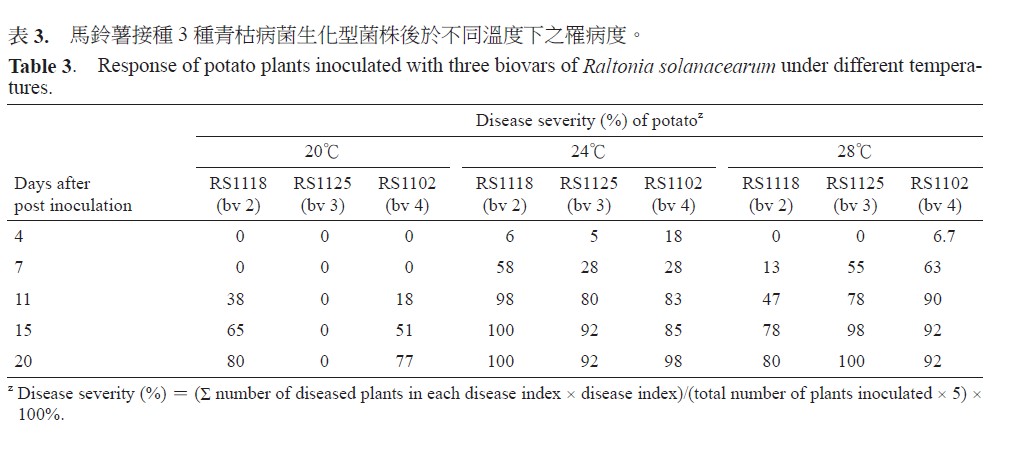All issues

Author:Ming-Fu Chuang, Shu-Fung Lo, and Ching-Yi Lin*
Abstract:
Bacterial wilt, caused by Ralstonia solanacearum, is an important disease of a wide range of crops in tropical and subtropical regions. Most strains of R. solanacearum are pathogenic at high temperatures, and some strains are nonpathogenic when the temperature drops below 20℃. However, race 3 biovar 2 (R3Bv2) strains can attack plants at cool temperatures. In this study, we surveyed the potato fields in Yunlin and Chiayi Counties in Taiwan during 2013–2014 and observed the incidences of wilting symptoms on potato, within 0–32%. The causal pathogens were identified and most of the stains were identified to be R. solanacearum biovar 2, indicating that the biovar 2 is a dominant strain to affect potato in Taiwan. In addition, the effects of temperature on the virulence of three R. solanacearum strains (RS1102, RS1118 and RS1125) and the representative biovars affecting solanaceous crops in Taiwan were evaluated on potato and tomato plants, respectively. Results indicated that all three strains showed strong virulence on potato and tomato plants at 24℃ and 28℃, and the disease severity ranged from 77 to 100% at 20 days of post inoculation. At 20℃, the three strains showed differential reactions on the inoculated potato. Among them, RS1125 (biovar 3) was nonpathogenic to potato, whereas RS1118 (biovar 2) showed higher virulence than the other two strains with 80–100% disease severity at 20 days of post inoculation. To compare the resistance between the current commercial potato cultivars to R. solanacearum race 3 biovar 2, ten cultivars [P86 (‘Kennebec’), P90 (‘Atlantic’), P91 (‘Tss-II’), P92 (‘Chipeta’), P95 (‘pike’), P117, P120 (‘TN-1’), P89, 16-13, and T3] were examined in this study. It indicated a differential susceptibilities among them, from susceptible to various degrees of tolerance, to the infection of R. solanacearum race 3 biovar 2. The disease severity ranged between 10–100% at 35 days of post inoculation. One cultivar, T3, showed the lowest disease severity at 10%. No cultivar exhibited immunity to the bacterium. Based on our results, we concluded that temperature is one of the factors that can affect the virulence of R. solanacearum. Comparing the virulence of three commonly found biovars of R. solanacearum in Taiwan at different temperatures, we suggest that bovar 2, which showed high virulence at cool temperatures, might be a great threat to the potato production in Taiwan.
Key words:Ralstonia solanacearum, Biovars, Temperature, Resistant
Download:![]() PDF Links
PDF Links
- 1. Development of Tractor-Mounted Seedling Transplanter for Sweet Potato
- 2. Synergistic Effect of Additional Gas on the Toxicity of Phosphine to Sitophilus oryzae and Sitophilus zeamais (Coleoptera: Dryophthoridae)
- 3. Effects of Temperature and Solar Radiation on Growth Traits and Plant Elements in Purple Leafy Sweet Potato
 Submit your manuscript
Submit your manuscript
 Guide for authors
Guide for authors